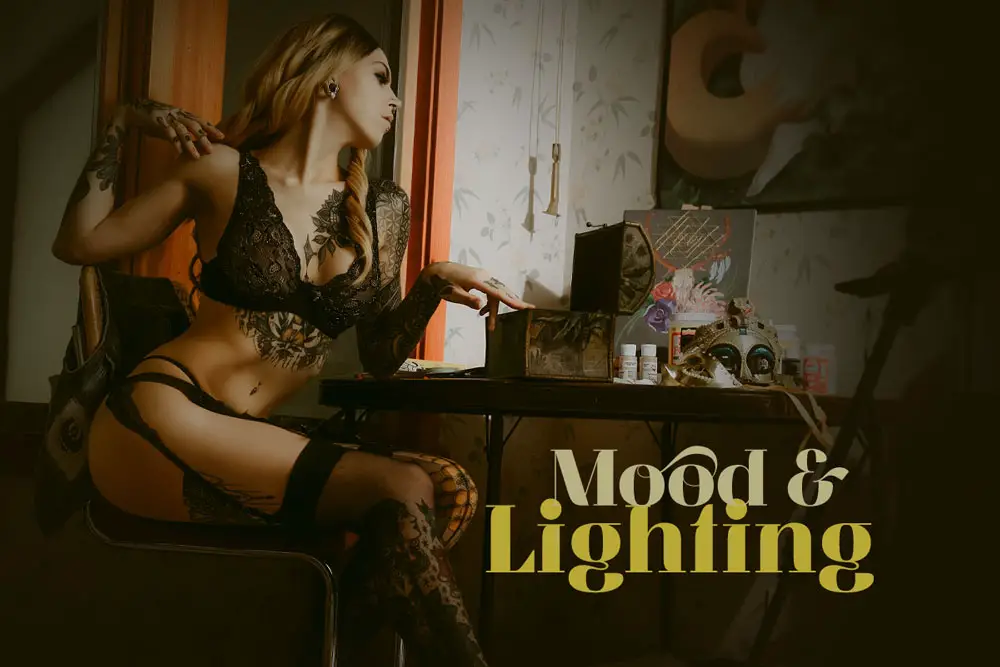
Lighting and Mood in Visual Narratives: How I Tell Stories with Light
Have you ever wondered how some images can make you feel something, think something, or do something? How some images can tell a story that words alone cannot? How some images can capture the essence of a person, a place, or a moment? If you have, then you are interested in visual narratives. Visual narratives are stories that are told through images and words. They can be used in various forms, such as photography, film, graphic design, and digital media. Visual narratives can evoke emotions, spark curiosity, and inspire action in the viewers.
One of the most important elements of visual storytelling is lighting. Lighting can create mood and atmosphere, highlight features, create contrast, and add depth to the story. Lighting can also influence the perception and emotional impact of an image. Lighting can turn a simple photograph into a powerful narrative.
How to Use Lighting and Mood to Create Powerful Visual Narratives
In this blog, I will share some tips and techniques on how to use lighting and mood to create powerful visual narratives, especially for portrait photography. Portrait photography is the art of capturing the inherent character of your subject within a photograph. It can be used to express personality, emotion, identity, and culture. Portrait photography can also tell a story about the subject, their environment, and their relationship with the photographer.
Table of Contents
Light: The First Character in Every Story. There is a hidden storyteller in every photograph. A storyteller that can make you feel, think, and imagine. A storyteller that can transform an image into a narrative. That storyteller is light. Light in photography is akin to the ink in a writer’s pen – essential and transformative. It can create mood, emotion, and atmosphere, making the viewer feel something beyond what they see. It can also enhance the composition, color, and contrast of your images, making them more visually appealing and impactful.
Lighting Basics
Lighting is one of the most important aspects of photography, as it can affect the mood, atmosphere, and quality of your images. In this section, we will explain the types and sources of lighting, the properties and effects of lighting, and the tools and techniques of lighting that you can use to create stunning visual narratives.
Natural lighting can vary depending on the time of day, the weather, and the season. It can create different effects, such as warm, cool, soft, or hard light. Natural lighting is often preferred by photographers for its realism and authenticity, but it can also be challenging to control and predict.
Artificial lighting can be more consistent and adjustable than natural lighting, but it can also be more expensive and complicated to use. Artificial lighting can create different effects, such as ambient, directional, or diffused light. Artificial lighting can be used to supplement or replace natural lighting, depending on the desired outcome.
Types and Sources of Lighting
There are three main types of lighting: natural, artificial and ambient. Natural lighting is the light that comes from the sun, the moon, or the stars. Artificial lighting is the light that comes from any man-made source, such as lamps, candles, or flash. Artificial can be ambient lighting or practical lighting, but ambient lighting can also be sourced from natural light.
Natural Light
The sun, our most ancient and dynamic light source, offers a range of moods depending on the time of day and weather conditions. The soft, diffused light of an overcast day can create a mood of introspection and calm, while the golden hues of sunrise or sunset imbue images with warmth and nostalgia. Natural light can also create realistic shadows and highlights that enhance your subject’s features. However, natural light can also be unpredictable and inconsistent, as it depends on factors such as weather, season, time zone, etc. Therefore, it’s important to plan ahead when shooting outdoors or indoors during daylight hours.
Natural light can tell stories of nature, beauty, and life. It can capture the changing seasons, the cycles of the day, and the moods of the weather. It can also reflect the emotions and expressions of your subject, whether it’s a person, an animal, or a plant.
Artificial Light
Studio lights, flashes, and other artificial sources offer controlled, consistent lighting. These tools allow photographers to create specific moods, from the stark, dramatic contrasts of a single light source to the gentle, even tones of diffused studio lights. Artificial light can also be used to create dramatic effects that draw attention to your subject or convey a certain mood or message. It can tell stories of creativity, imagination, and style. It can create scenes that are not possible with natural light, such as surreal, fantasy, or futuristic settings. It can also express your personal vision and artistic flair, by using light as a medium to paint, sculpt, or design your images.
You can use a single flash or strobe to create strong contrasts between light and dark areas, or you can use multiple lights to create different patterns or shapes. You can also use color temperature filters or gels to change the hue or intensity of your artificial light.
Ambient Light
Often overlooked, ambient light – the light already present in a scene – can set the stage for a narrative. Whether it’s the neon glow of city streets or the soft luminescence of a candlelit room, ambient light carries emotional weight. Ambient light can also add subtle details or textures that enhance your subject’s appearance or atmosphere. Ambient light can tell stories of culture, history, and mood. It can capture the essence of a place, a time, or a situation, by using the existing light sources as clues or symbols. It can also create a sense of intimacy, connection, or emotion, by using the ambient light to set the tone and mood of your image.
For example, you can use ambient light to create a story of romance and passion by photographing a couple in a dimly lit restaurant, or a story of adventure and excitement by photographing a street performer in a bustling city.
You can use ambient light from windows or lamps to create soft shadows or highlights on your subject’s face, or you can use ambient light from candles or fireplaces to create cozy warmth.
By understanding these types of lighting and how they affect mood, you will be able to choose the best lighting for your photography project. You will also be able to experiment with different combinations and techniques that suit your style and vision. Remember that lighting is not only about technical aspects; it’s also about artistic expression. So have fun with it!
Properties and Effects of Lighting
Lighting has four main properties that can affect the appearance and quality of your images: intensity, direction, color, and quality.
Intensity:
Intensity is the brightness or darkness of the light. It can affect the exposure, contrast, and detail of your images. You can adjust the intensity of the light by changing the distance, angle, or power of the light source, or by using filters or modifiers.
Direction:
Direction is the angle or position of the light relative to the subject. It can affect the shape, texture, and depth of your images. You can change the direction of the light by moving the light source, the subject, or the camera, or by using reflectors or modifiers.
Color:
Color is the hue or temperature of the light. It can affect the mood, atmosphere, and tone of your images. You can change the color of the light by using different types of light sources, such as tungsten, fluorescent, or LED, or by using filters or modifiers.
Quality:
Quality is the softness or hardness of the light. It can affect the shadows, highlights, and edges of your images. You can change the quality of the light by using different sizes, shapes, or distances of the light source, or by using diffusers or modifiers.
The mood of a photograph – that elusive feeling that captivates the viewer – is often a direct result of the lighting choices made by the photographer. Light is more than a tool; it is a storyteller. It can create mood, emotion, and atmosphere, making the viewer feel something beyond what they see. The true skill in portrait photography lies in using light not just to illuminate, but to inspire, to communicate, to tell a story.
There are several types of light that photographers can harness, each with its unique characteristics and emotional tones. Let’s explore them one by one and see how they can create stories in our photography:
Soft Light:
The Gentle and Tender Soul. Soft light is the light of love, compassion, and peace. It is the light that caresses your subject, smoothing out the imperfections and creating a sense of intimacy and vulnerability. Soft light can be found in cloudy days, shaded areas, or diffused sources. It can create a serene and cozy mood, perfect for capturing emotions and relationships.
Hard Light:
The Bold and Dramatic Spirit. Hard light is the light of contrast, tension, and power. It is the light that challenges your subject, highlighting the features and creating a feeling of rawness and intensity. Hard light can be found in sunny days, direct sources, or reflected surfaces. It can create a dramatic and striking mood, ideal for capturing action and expression.
High Key and Low Key Lighting:
The Light and Dark Twins. High key and low key lighting are the extremes of light and shadow, the opposites that attract and repel. High key lighting is the light of brightness, optimism, and joy. It is the light that fills your image with minimal shadows, creating a sense of positivity and lightness. Low key lighting is the light of darkness, mystery, and sadness. It is the light that leaves your image with dominant shadows, creating a sense of suspense and melancholy.
By understanding these types of lighting and how they affect mood, you will be able to choose the best lighting for your photography project. You will also be able to experiment with different combinations and techniques that suit your style and vision. Remember that lighting is not only about technical aspects; it’s also about artistic expression. So have fun with it!
While the artistic choice of lighting sets the stage for mood, technical know-how is what brings this vision to life. Understanding and manipulating camera settings, light placement, and modifiers are important in creating the desired atmosphere in portrait photography.
Camera Settings for Mood:
Aperture, shutter speed, and ISO are the three main camera settings that determine how light is captured. They also affect the depth of field, motion blur, and noise of your images. By adjusting these settings, you can create different moods in your portraits. For example, a wide aperture can create a dreamy mood with a shallow depth of field, isolating your subject from the background. A slower shutter speed can introduce motion, adding a dynamic element to the narrative. A higher ISO can create a grainy effect, adding a sense of realism or nostalgia.
Light Placement and Direction:
The direction and placement of light sources significantly impact the mood. They also affect the shadows and highlights of your images, creating contrast and depth. By changing the angle and distance of your light sources, you can create different moods in your portraits. For example, side lighting can create drama and depth, emphasizing the shape and texture of your subject. Backlighting can silhouette a subject for mystery, creating a rim light around the edges. Front lighting can provide clarity and openness, flattening the features and reducing the shadows.
Using Modifiers to Shape Light:
Modifiers are accessories that help shape and control light. They can soften, diffuse, reflect, or focus light, creating different effects and moods. By using different modifiers, you can create different moods in your portraits. For example, softboxes can soften light for a gentle mood, creating a large and even light source. Snoots and grids can focus light for dramatic, pinpointed effects, creating a small and concentrated light source. Umbrellas and reflectors can bounce light for a natural mood, creating a fill light or a catch light.
Color Temperature and Gels:
Color temperature and colored gels can be used to add emotional cues. Color temperature is the measure of the hue or tone of light, ranging from warm to cool. Colored gels are transparent filters that change the color of light. By using different color temperatures and gels, you can create different moods in your portraits. For example, warm tones often convey comfort and intimacy, creating a cozy and inviting atmosphere. Cooler tones can evoke feelings of detachment or melancholy, creating a cold and distant atmosphere.
Mastering these technical aspects empowers photographers to precisely control how their lighting choices affect the mood and narrative of their portraits. It’s about having the tools and knowledge to bring an artistic vision to life, turning a concept into a captivating visual story.
Mood is the overall feeling or atmosphere that a visual narrative creates. It can be influenced by lighting, composition, color, and other elements. Mood can convey emotions and stories that words alone cannot.
What is Mood and What are its Components?
Mood is a subjective and emotional response to a visual narrative. It can be described as having a positive or negative valence, such as happy, sad, angry, or calm. Mood can also be described as having a certain intensity, such as mild, moderate, or strong.
Mood has several components that can affect how it is perceived and expressed. Some of these components are:
Emotion:
The specific feeling that is evoked by a visual narrative, such as joy, fear, or surprise. [Learn More]
Atmosphere:
The general tone or mood that is created by a visual narrative, such as cozy, eerie, or romantic.
Tone:
The attitude or perspective that is conveyed by a visual narrative, such as humorous, serious, or ironic.
Conflict:
The tension or opposition that drives the plot and the characters of a visual narrative, such as man vs. man, man vs. nature, or man vs. self. Conflict can create a sense of drama, suspense, or resolution in the mood.
Imagery:
The use of sensory details and figurative language to create vivid pictures in the mind of the viewer, such as metaphors, similes, or symbols. Imagery can create a sense of realism, fantasy, or emotion in the mood.
What are the Factors and Influences of Mood?
Mood can be influenced by various factors, both internal and external. Some of these factors are:
Lighting:
The type, source, direction, color, and quality of light that is used in a visual narrative. Lighting can create different effects, such as warm, cool, soft, or hard light.
Composition:
The arrangement of elements in a visual narrative, such as subjects, backgrounds, colors, and space. Composition can create different effects, such as balance, contrast, depth, and focus. [Learn More]
Color:
The hue, saturation, and value of colors that are used in a visual narrative. Color can create different effects, such as harmony, tension, mood, and emotion. [Learn More]
Other elements:
The use of other elements, such as sound, music, text, or symbols, that can enhance or complement a visual narrative. These elements can create different effects, such as rhythm, meaning, context, and expression.
What are the Tools and Techniques of Mood?
There are many tools and techniques that can be used to manipulate and enhance the mood of a visual narrative. Some of the most common ones are:
Color grading:
The process of adjusting the color, contrast, and brightness of a visual narrative to create a desired mood or effect. Color grading can be done using software, filters, or editing tools.
Filters:
The devices or effects that can alter the appearance or quality of a visual narrative. Filters can be used to change the color, tone, texture, or style of a visual narrative.
Editing:
The process of selecting, arranging, and modifying the elements of a visual narrative to create a coherent and effective story. Editing can be done using software, tools, or techniques.
In the next sections, we will explore how to use lighting and mood to create powerful visual narratives, especially for portrait photography.
Portrait photography is the art of capturing the inherent character of your subject within a photograph. It can be used to express personality, emotion, identity, and culture. Portrait photography can also tell a story about the subject, their environment, and their relationship with the photographer.
The purpose of portrait photography is to create a visual representation of a person or a group of people that reveals something about who they are, what they feel, or what they do. Portrait photography can be used for various reasons, such as personal, professional, artistic, or social.
Some of the challenges of portrait photography are:
Finding the right location and background that suits the subject and the mood of the portrait.
Choosing the appropriate lighting and mood that enhances the features and expression of the subject.
Posing the subject in a way that looks natural, comfortable, and flattering.
Communicating with the subject and building rapport and trust.
Editing and retouching the portrait to achieve the desired effect and quality.
There are many different styles and genres of portrait photography that can be used to create different effects and stories. Some of the most common ones are:
Traditional portraits:
These are portraits that depict the subject looking at the camera and posing in a formal or classic way. They are usually shot in a studio with a plain background and a simple lighting setup. They are often used for official or professional purposes, such as ID photos, headshots, or yearbook photos.
Lifestyle portraits:
These are portraits that capture the subject in their natural environment and doing their everyday activities. They are usually shot on location with ambient or natural light and a candid or relaxed style. They are often used for personal or social purposes, such as family photos, travel photos, or blog photos.
Environmental portraits:
These are portraits that show the subject in a specific context or setting that relates to their occupation, hobby, or personality. They are usually shot on location with a mix of artificial and natural light and a creative or dramatic style. They are often used for editorial or commercial purposes, such as magazine photos, advertising photos, or documentary photos.
Glamour portraits:
These are portraits that emphasize the beauty, attractiveness, or sexuality of the subject. They are usually shot in a studio or a glamorous location with a sophisticated lighting setup and a stylized or provocative style. They are often used for fashion or entertainment purposes, such as modeling photos, celebrity photos, or boudoir photos.
Fine art portraits:
These are portraits that express the artistic vision or concept of the photographer or the subject. They are usually shot in a studio or a unique location with a complex lighting setup and an experimental or abstract style. They are often used for artistic or personal purposes, such as exhibition photos, portfolio photos, or self-portraits.
There are many different lighting and mood scenarios that can be used to create different effects and stories in portrait photography. Some of the most common ones are:
Low-key lighting:
This is a lighting scenario that uses a dark background and a single or minimal light source to create a high contrast and dramatic mood. It is often used to create a sense of mystery, suspense, or intensity in the portrait.
High-key lighting:
This is a lighting scenario that uses a bright background and multiple or diffuse light sources to create a low contrast and cheerful mood. It is often used to create a sense of innocence, happiness, or simplicity in the portrait.
Rembrandt lighting:
This is a lighting scenario that uses a single or directional light source placed at a 45-degree angle from the subject to create a triangular-shaped shadow on the opposite cheek. It is often used to create a sense of depth, texture, and realism in the portrait.
Butterfly lighting:
This is a lighting scenario that uses a single or frontal light source placed above and behind the camera to create a butterfly-shaped shadow under the nose. It is often used to create a sense of elegance, glamour, and symmetry in the portrait.
Color gel lighting:
This is a lighting scenario that uses colored filters or gels attached to the light sources to create a colorful and creative mood. It is often used to create a sense of fun, fantasy, or emotion in the portrait. This will be my favorite technique going forward, for building my project www.dangergirlx.com.
Loop lighting:
This is a lighting scenario that uses a single or directional light source placed at a 45-degree angle from the subject and slightly above the eye level. It creates a small loop-shaped shadow under the nose that does not touch the cheek. It is often used to create a natural and flattering mood in the portrait.
Split lighting:
This is a lighting scenario that uses a single or directional light source placed at a 90-degree angle from the subject. It divides the face into two equal halves, one lit and one in shadow. It is often used to create a dramatic and contrasty mood in the portrait.
Window light:
This is a lighting scenario that uses natural light coming from a window as the main light source. It can create different effects depending on the size, shape, and position of the window, as well as the time of day and the weather. It is often used to create a soft and cozy mood in the portrait.
Practical lighting:
This is a lighting scenario that uses existing light sources in the environment, such as lamps, windows, or candles, to create a natural and realistic mood. It is often used to create a sense of intimacy, authenticity, or atmosphere in the portrait. Practical lighting can also create interesting shapes, colors, and textures on the subject and the background.
Clamshell lighting:
This is a lighting scenario that uses two light sources, one above and one below the subject, to create a soft and flattering mood. It is often used to minimize shadows, wrinkles, and blemishes on the subject’s face. Clamshell lighting can also create a catchlight in both eyes, making them more expressive and lively.
Edge lighting:
This is a lighting scenario that uses one or more light sources behind the subject, to create a rim or outline of light around them. It is often used to create a sense of separation, depth, and drama in the portrait. Edge lighting can also highlight the shape, texture, and movement of the subject and their hair or clothing.
Lighting and mood are essential elements of portrait photography. They can create powerful visual narratives that capture the character, emotion, and story of your subject. By using different techniques and effects, you can create stunning portrait photographs that will captivate your viewers and make them feel something, think something, or do something. I hope you enjoyed this section and learned something new. Thank you for reading.
Visual narratives are not limited to portrait photography. They can also be found in other forms of visual arts, such as film, graphic design, digital media, and more. In this section, we will explore the similarities and differences between portrait photography and other visual narratives, and how lighting and mood can be used to create different effects and stories in them.
Portrait photography and other visual narratives share some common elements, such as composition, color, and symbolism. They also use similar techniques, such as lighting, mood, and editing, to convey meaning and emotion. However, they also have some distinct features, such as:
Medium:
Portrait photography uses still images, while other visual narratives can use moving images, such as video, animation, or illustration. Moving images can create a sense of motion, continuity, and time, while still images can create a sense of stillness, isolation, and moment.
Format:
Portrait photography usually uses a single image or a series of images, while other visual narratives can use a combination of images, text, sound, and music. These elements can create a richer and more complex narrative, but they can also pose challenges in terms of coherence, consistency, and clarity.
Audience:
Portrait photography usually targets a specific audience, such as the subject, the client, or the photographer, while other visual narratives can target a wider and more diverse audience, such as the public, the fans, or the critics. This can affect the choice of style, genre, and message of the visual narrative, as well as the expectations and feedback of the audience.
Lighting and mood can be used to create different scenarios for other visual narratives, depending on the genre, theme, and purpose of the story. Some examples are:
Horror:
This is a genre that uses lighting and mood to create a sense of fear, suspense, and dread in the audience. Lighting and mood techniques that can be used for horror are low-key lighting, backlighting, shadows, contrast, and cool colors. These techniques can create a dark, gloomy, and mysterious atmosphere, and hide or reveal the source of the horror.
Comedy:
This is a genre that uses lighting and mood to create a sense of humor, fun, and joy in the audience. Lighting and mood techniques that can be used for comedy are high-key lighting, front lighting, bright colors, and contrast. These techniques can create a light, cheerful, and lively atmosphere, and highlight or exaggerate the funny aspects of the story.
Fantasy:
This is a genre that uses lighting and mood to create a sense of wonder, imagination, and magic in the audience. Lighting and mood techniques that can be used for fantasy are color gel lighting, rim lighting, warm colors, and harmony. These techniques can create a colorful, glowing, and ethereal atmosphere, and show the fantastical elements of the story.
Lighting and mood techniques can be adapted and applied to different mediums and formats of other visual narratives, such as:
Cinematography:
This is the art of capturing moving images for film or video. Cinematography uses similar lighting and mood techniques as photography, but it also considers the movement of the camera, the subject, and the scene. Cinematography can use different camera angles, shots, and movements to create different effects and perspectives.
Animation:
This is the art of creating moving images by drawing, painting, or computer graphics. Animation uses similar lighting and mood techniques as illustration, but it also considers the movement of the characters, the objects, and the background. Animation can use different styles, techniques, and effects to create different expressions and emotions.
Illustration:
This is the art of creating still images by drawing, painting, or computer graphics. Illustration uses similar lighting and mood techniques as photography, but it also considers the style, genre, and message of the image. Illustration can use different shapes, lines, and textures to create different forms and details.
In conclusion, lighting and mood are essential elements of other visual narratives. They can create powerful visual narratives that capture the genre, theme, and purpose of the story. By using different techniques and effects, you can create stunning visual narratives that will captivate your viewers and make them feel something, think something, or do something. I hope you enjoyed this section and learned something new.
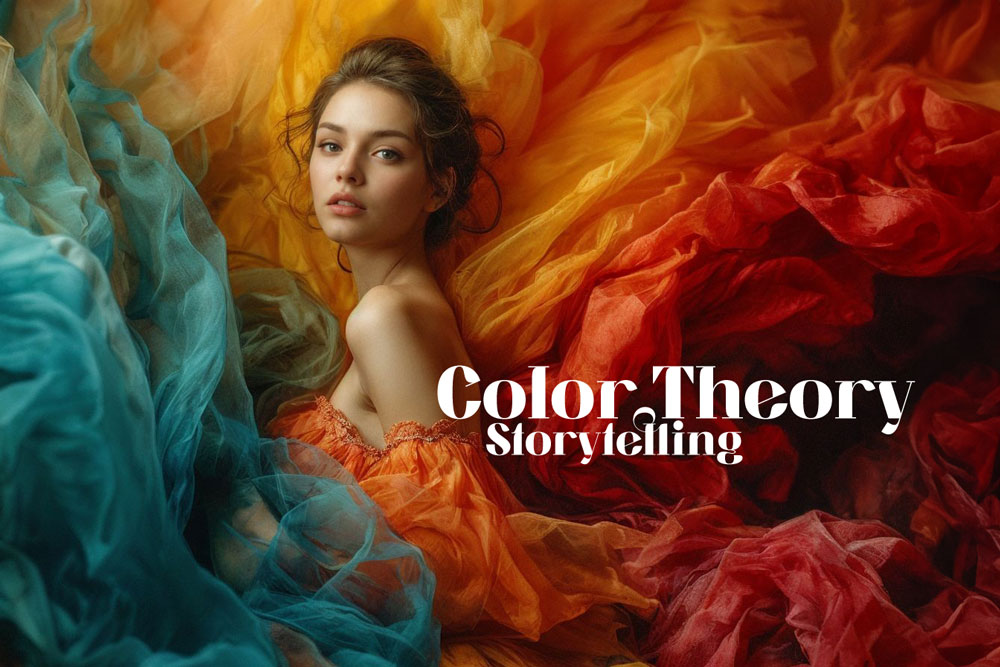
Master the art and science of color theory in storytelling photography. Learn how to evoke emotions and create captivating images with Photography Color Theory.
We have reached the end of this blog. I hope you have enjoyed reading it and learned something new. In this blog, we have covered the following topics:
The basics of lighting and mood and how they affect visual storytelling
The different styles and genres of portrait photography and how to use lighting and mood to create them
The similarities and differences between portrait photography and other visual narratives and how to use lighting and mood to create them
The examples and resources that will inspire and help you in your visual storytelling journey
Lighting and mood are essential elements of visual storytelling. They can create powerful visual narratives that capture the character, emotion, and story of your subject. By using different techniques and effects, you can create stunning visual narratives that will captivate your viewers and make them feel something, think something, or do something.
Now, it’s your turn to practice and experiment with lighting and mood in your own visual narratives. Whether you are a portrait photographer, a film maker, a graphic designer, a digital artist, or anything else, you can use lighting and mood to create amazing visual stories that will impress your audience and express your vision.
If you liked this blog, please share it with your friends, colleagues, or anyone who might be interested in visual storytelling. Also, please leave a comment below and let me know what you think of this blog, or if you have any questions, suggestions, or feedback. I would love to hear from you and learn from you.
Thank you for reading this blog and for joining me in this visual storytelling adventure. I hope to see you again soon.
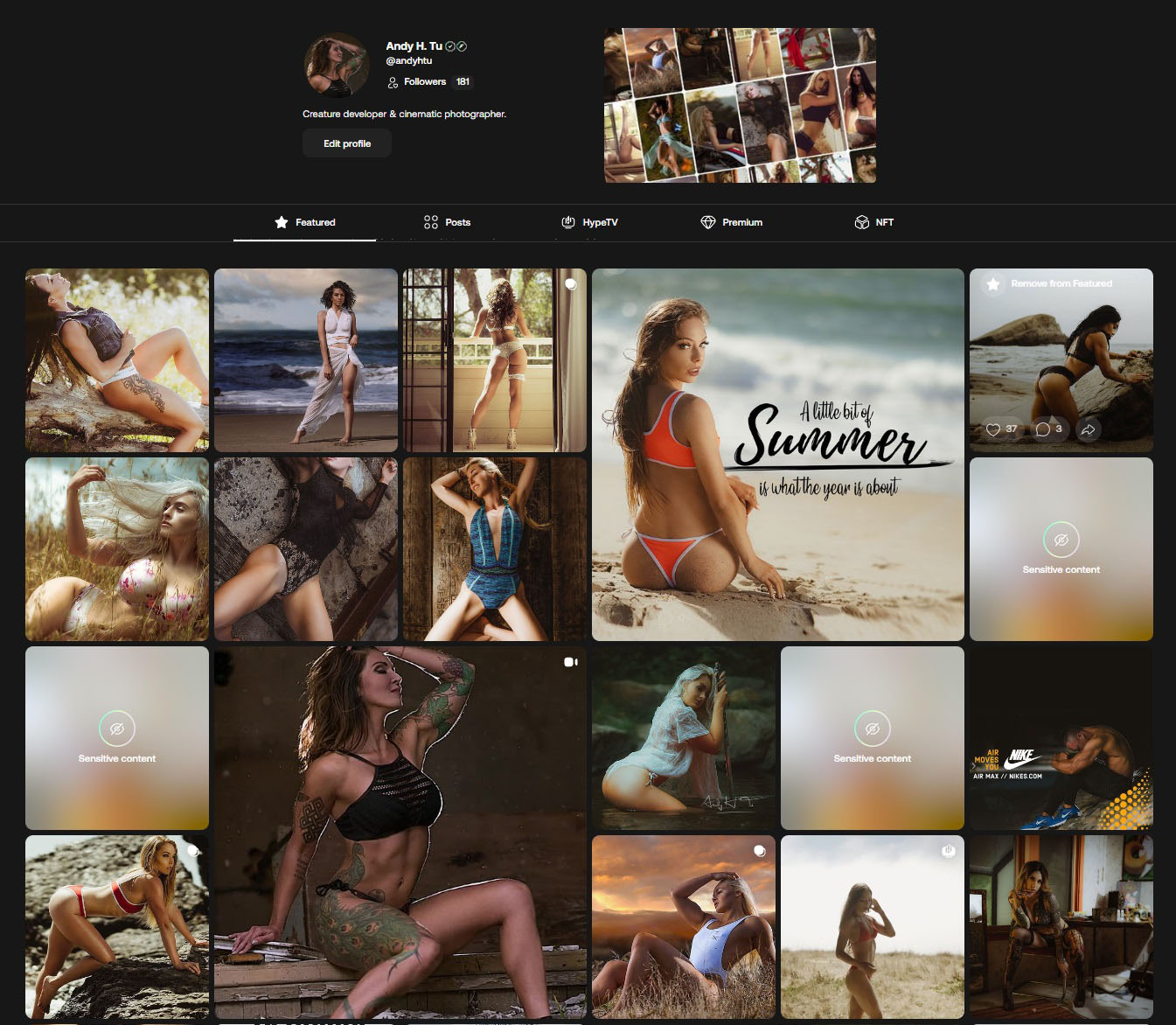


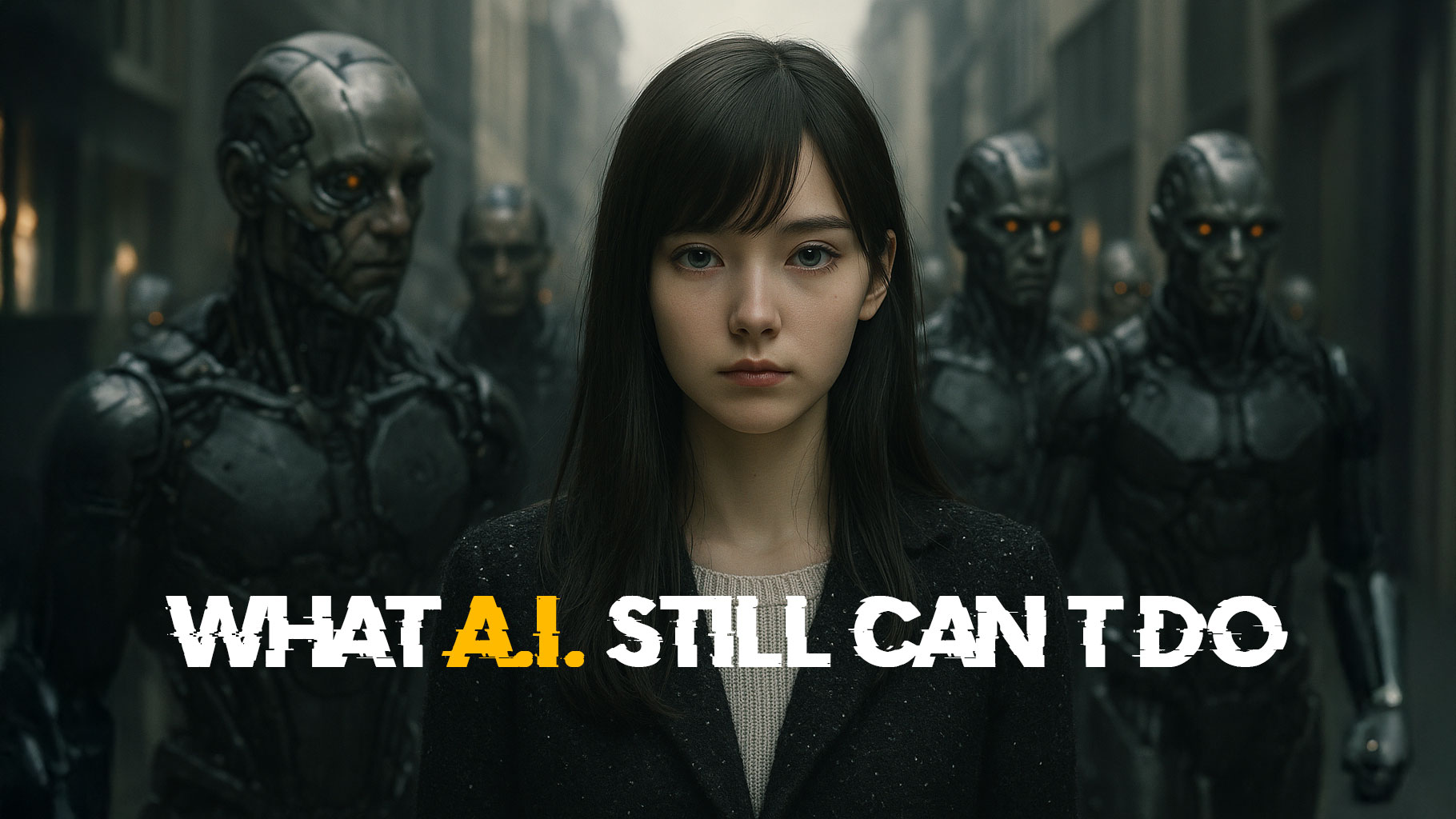


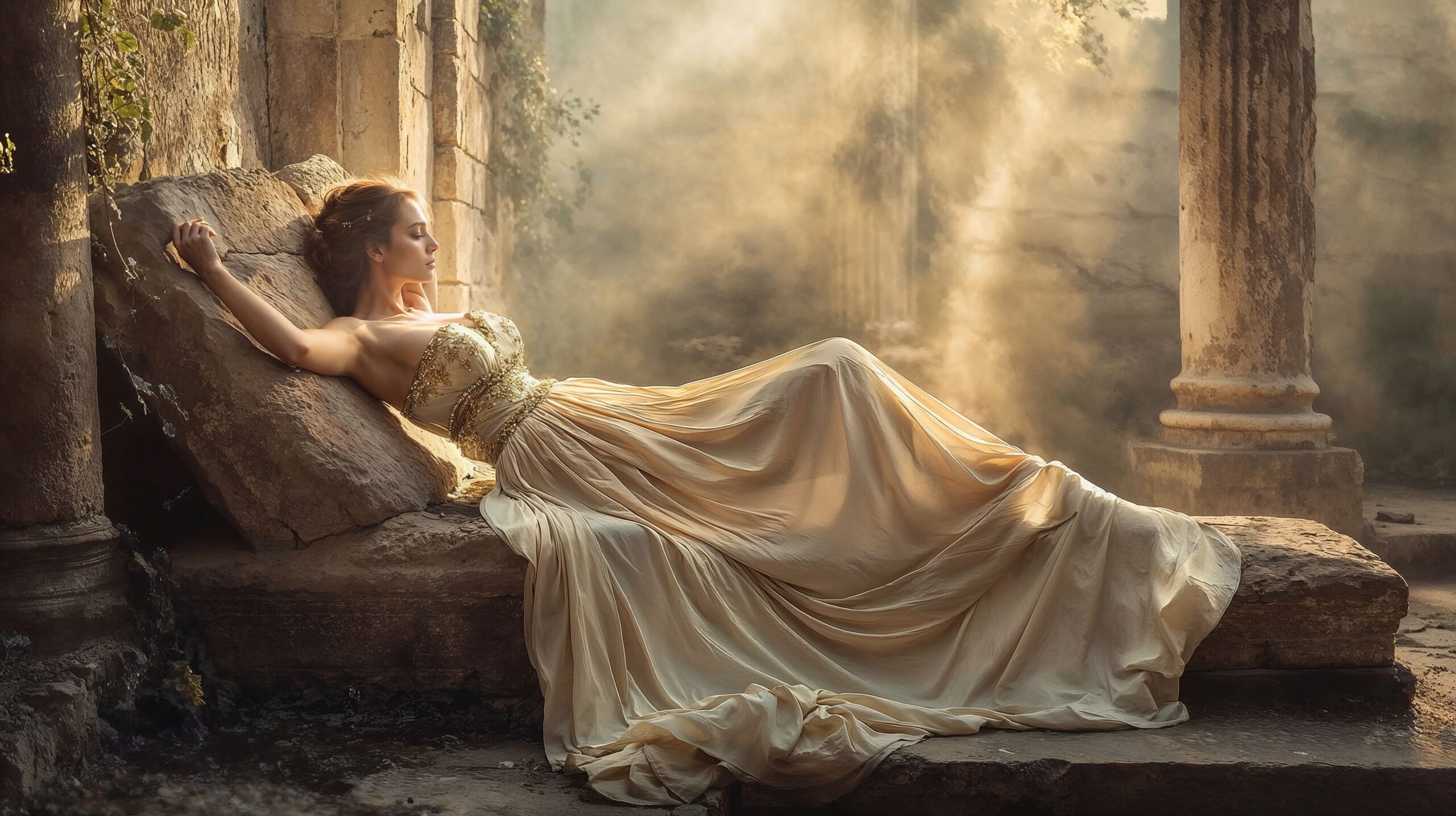

Leave a Reply